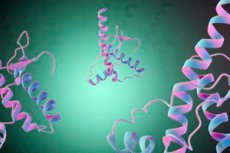New publications
Repurposing human-approved drugs for the treatment of prion diseases
Last reviewed: 02.07.2025

All iLive content is medically reviewed or fact checked to ensure as much factual accuracy as possible.
We have strict sourcing guidelines and only link to reputable media sites, academic research institutions and, whenever possible, medically peer reviewed studies. Note that the numbers in parentheses ([1], [2], etc.) are clickable links to these studies.
If you feel that any of our content is inaccurate, out-of-date, or otherwise questionable, please select it and press Ctrl + Enter.

Prions are abnormal pathogens that can be transmitted and cause certain normal cellular proteins to misfold. Prion diseases are the general name for a group of incurable and fatal neurodegenerative diseases that affect not only humans but also wild and domestic animals. These diseases include Creutzfeldt-Jakob disease (CJD) in humans, bovine spongiform encephalopathy (BSE, or "mad cow disease") in cattle, and chronic wasting disease (CWD), which affects deer, elk, and moose.
The key event in these diseases is the conversion of the prion protein (PrPC) from its normal form to a pathological structure (PrPSc) that is toxic to neurons and can self-replicate by binding to unconverted PrPC molecules. This self-replicating ability makes these misfolded proteins infectious, with enormous public health implications.
In a new study, researchers from Boston University's Chobanian and Avdisian School of Medicine identified 10 compounds that were able to reduce PrPSc levels in infected cells and showed that the most potent molecules could also prevent the toxicity seen when PrPSc was applied to cultured neurons.
"Excitingly, five of these molecules are already in medical use: rimcazole and haloperidol for the treatment of neuropsychiatric conditions, (+)-pentazocine for the treatment of neuropathic pain, and SA 4503 and ANAVEX2-73 in clinical trials for the treatment of ischemic stroke and Alzheimer's disease, respectively," explained lead author Robert S.S. Mercer, Ph.D., a professor of biochemistry and cell biology at the school.
The researchers initially studied the anti-prion properties of these molecules because they were known to bind to sigma receptors (σ1R and σ2R), which were thought to be involved in prion proliferation. Using gene knockout technology (CRISPR), they found that sigma receptors were not the targets of these drugs for their anti-prion properties.
Using Neuro2a (N2a) cells from an experimental prion-infected model, the cells were exposed to increasing concentrations of each drug and PrPSc levels were determined. They then used CRISPR technology to ‘edit’ the σ1R and σ2R genes so that they no longer coded for the protein, and found that this had no effect on the reduction in PrPSc levels seen with the drugs. This led them to conclude that σ1R and σ2R were not responsible for the anti-prion effects of these drugs. They then tested the ability of these drugs to inhibit the conversion of PrPC to PrPSc and found that they had no effect on these reactions outside of cells, indicating that another protein was involved in the drugs’ actions.
Prion diseases have enormous public health implications, from the safety of the blood supply to the proper disinfection of surgical instruments used in neurosurgery, the researchers said. "From a clinical perspective, we believe this study has identified antiprion properties in drugs that have already been shown to be safe for use in humans. Because of this, especially given the lack of effective treatments for these diseases, these compounds may be repurposed to treat prion diseases," said senior study author David A. Harris, MD, PhD, professor and chair of the Department of Biochemistry and Cell Biology at the school.
These results are published online in the journal ACS Chemical Neuroscience.
